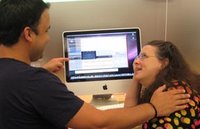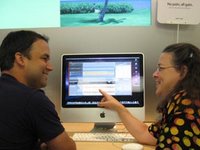Education
Studio Is a Buzz!

The contract came in for the new newsboy. I’m not sure I can divulge where it is going. Something for which to look forward.
Meanwhile I’m reviewing and learning to use the Next Engine Scanner. Be prepared to see some video coming up on this process in the near future. Yes, the price tag looks hefty, however you must remember that sending one sculpture out for scanning can cost about $1,000.
This tool has so many applications for the studio. I just can’t wait to share it with everyone. I’m working on an article for my column at Best of Artists and Artisans website. I’ll let you know when it is up.
Fooling Around- in Mudbox

A very good exercise in traditional sculpture is to set a timer and sculpt something as quickly as possible. It keeps you form getting bogged down in the details. As I begin to work in mudbox I gave myself that same exercise. Of course I always like working from funny photographs and I love people, so here is one I found to work from. It felt good to put “gram” aside and work on something fast. I may do a couple more of this one and then it is on to a little child or baby funny face. the first one was done in 28 minutes( I had to go to church) the others 30 minutes.
A Picture Is Worth A Thousand Words
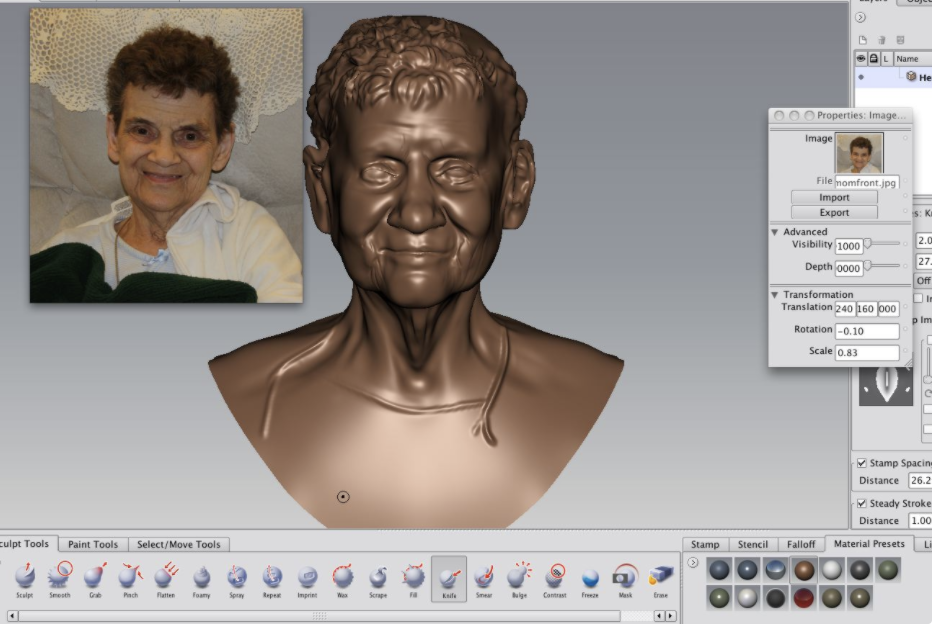
I thought I would share this with you. As usual maybe you can follow along. This is Mudbox. I am working on my first portrait. Here is mom. Yes, the wonderful woman that is found on our podcast, and is known as “gram”. Anyway, it is a long drawn out process of sculpting in Mudbox but she is coming along.
This is what all my fuss has been about in the last few weeks, needing more RAM, new graphics card. And now to find the one thing that was bugging me may actually be a bug in OS 10.5.7. But, today I can use Mudbox again, and I am thrilled to be able to do so.
Mudbox For The Mac!
I now have Mudbox for the Mac. I’m thrilled and can’t wait to see how it works. It will be great to run this in my native operating system instead of on bootcamp. Yes, bootcamp is nice, but when you have to log off and on to do other things that is a pain. Now, lets get busy on writing this Mudbox book “Digital Sculpting with Mudbox: Essential Tools and Techniques For Artists.”
I am excited about working in mudbox, but the sculptor in me has a few concerns.
I want to be able to have a blob of clay- push and pull it until I “feel” what I want.
Doing this in mudbox can change the topography to something that is unworkable. So. I either need to learn another program and bring in what I want, or… perhaps retopologize what I create. But where does one find the retopologizing tools? That is the part of the learning curve as traditional sculptor goes digital.
New Article- A Review of New Technology for the Traditional Studio at the Siggraph Convention
New Article- A Review of New Technology for the Traditional Studio at the Siggraph Convention
Best of Artists and Artisans finally got my new article up. Check it out.
The snail mail section is so funny. This article was complete a while ago and I am thrilled to be able to share more information in the near future concerning some of my other finding on technology in the traditional studio.
A New Video- Digital Art In The Traditional Sculpting Studio
This video documents the process of bringing digital art into the traditional sculpture studio. It is of 3 different sculptures and as promised it is an update on how the Jenna sculpture was taken from poser to clay.
Cool Stuff in Technology- And Introduction to a Technology Symposium That I Am Putting on Next Year
I have been working on a technology symposium for Houston next year. HUGE PROJECT! more about that later. I found RabbitHole printing at Siggraph this year and just loved it. I’m hoping they will be at the symposium. This stuff reminds me of looking through my view master toy in the 60’s,
but it is much more intense and active. Is it a shadow box? Is it a print? Is it sculpture? To help with the load time of my blog I’ll direct you to the link for this video http://vimeo.com/1767780?pg=embed&sec=1767780 VIDEO NO LONGER AVAILABLE.
Art and Technology?
I have recently returned from the computer graphics convention called Siggraph in LA. My job was to focus on how technology was entering the art studio. I have been intrigued by this concept since writing about the digital milling and scanning process this past spring for Sculpture Review magazine. I do hope to create a few videos on the subject and am looking for a venue that would like to receive regular articles on both technology in the fine art studio and psychology and art/creativity. Two subjects that intrigue me. In the meantime please be sure to check out this blog as well as my online column at Best of Artists and Artisans and read about the wonderful things that I found at the convention. I can’t wait to share!




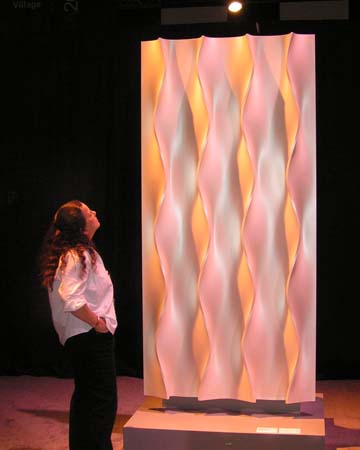
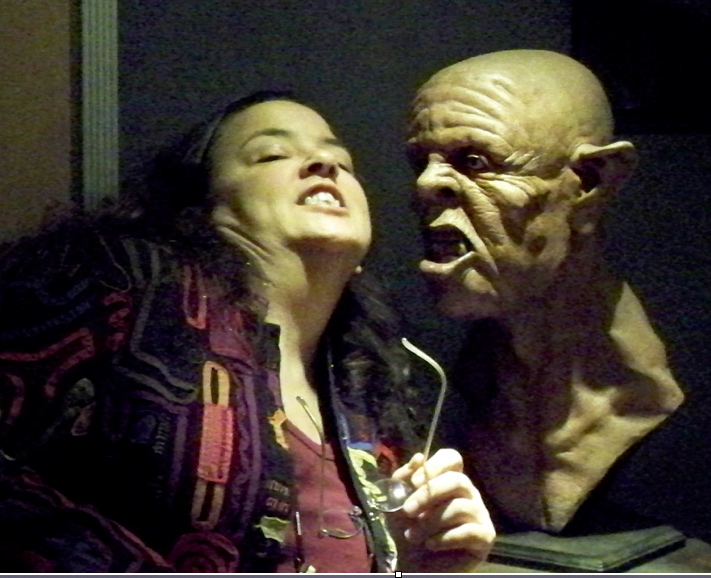
A Review of New Technology For The Traditional Studio at the SIGGRAPH Convention
Writings by Ms. Mongeon
Created for Best of Artists and Artisans web site
By Bridgette Mongeon © 2008

Using technology in a traditional art studio can, at first, feel like cheating or it may bring a fear that the technology can somehow overtake the craft and creativity. I mentioned these fears and my introduction to this topic in a recent article titled Exploring Digital Technologies as Applied to Traditional Sculpting– Sculpture Review Winter 2007. In the article, I explored incorporating digital scanning and milling in the traditional sculpting studio. My research alleviated my original concerns and fears as I realized that digital enlargement, though a little intimidating at first, can be combined with traditional techniques offering another tool to use in my creative process, a tool that has the added benefit of providing me with more time to create.
I continued my research into utilizing technology in the traditional art studio while attending the 2008 Siggraph Convention this past August. Siggraph is short for Special Interest Group on Graphics and Interactive Techniques.
I once considered Siggraph as a convention for those working in graphics since it relates to illustration or computer generated special affects for movies. I have watched with curiosity over the years as the technology that has been introduced at Siggraph has infiltrated the 3D world outside the computer and into traditional sculpture studio. Those at Siggraph also seemed to be embracing the idea of bringing technology into the art studio. Three prime areas, besides the main floor of exhibitors, displayed this same exploration.
THE STUDIO
The Studio section hosted six established and emerging resident artists, along with hands on participation for learning and creating in 2d, 3d, and 4d (fourth dimension is time.) Though The Studio contained quite a bit of resources, two visiting artists captured my attention.
Matt Shlian calls himself a paper engineer, creating elaborate sculptures through the use of folded paper, which is not to be confused with true origami because he cuts and glues. My intrigue with the art was that many of the forms generate movement, changing shape with the interaction of the viewer.
It is interesting to point out that many of the artists I researched who were working with technology in their art also crossed over into the area of science. A segment of Matt’s website states this.
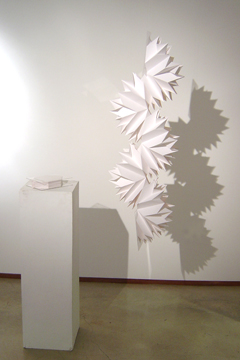
“As a paper engineer my work is rooted in print media, book arts and commercial design. Beginning with an initial fold, a single action causes a transfer of energy to subsequent folds, which ultimately manifest in drawings and three-dimensional forms. I use my engineering skills to create kinetic sculpture, which have lead to collaborations with scientists at the University of Michigan. We work on the nanoscale, translating paper structures to micro origami. Our investigations extend to visualizing cellular division and solar cell development. Researchers see paper engineering as a metaphor for scientific principals; I see their inquiry as basis for artistic inspiration.”
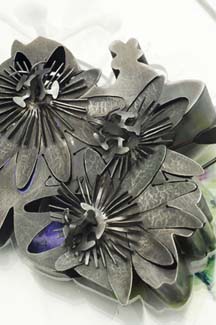
Another person that caught my eye was metal smith and jeweler, Sondra Sherman. I told Sondra that my goal as media at Siggraph was to find artists who were bringing technology into their studio, and she made sure that I knew that her present designs were created by hand, but that learning about the technology that would apply to her art studio was also her goal while at Siggraph. “I believe artists in craft media are always curious about means or materials which might enhance or facilitate their creative expression and which seduces the viewer to engage with the work. I am not interested in the ‘novelty for its own sake’ quality, which the use of technology might bring to my artwork. I am interested in how I might use the attention given to novel forms/materials to attract the viewer to consider what I might be trying to express with that form, as they would with work created in any media or by any means.”
SLOW ART
Slow Art was a juried exhibition. Artists were asked to “reconsider the paradigm of speed and instead consider the concept of “slow art.”’ The questions that were raised— how do you employ speed afforded by technology, how does it affect the work, and the process of creating slow art?
There were a variety of pieces of art in this section that peeked my interest. One of mention was an interactive piece that is the literal description of slow, titled —RealSnailMail. In this exhibit you send an e-mail on a designated computer in the slow art exhibit. It is then sent to a server in the UK. Here the e-mail is in a holding pattern along with the many other e-mails as it waits for a snail equipped with a transmitter in a tank at Bournemouth University, UK, to slide into range of a hot spot that can pick up your message. It then must move to another area of the tank to send it.
I could not help but wonder just how long my snail mail would take to get to a person. I emailed Bournemouth University in the UK using the regular fast e-mail and they quickly replied. “We have done a bit of calculating this morning. As of the 8th of Sept. 2008 we have 8,977 emails waiting. Based on this, if you sent an email today, it would take 24 years, 217 days before it gets to the front of the queue. It then may take a further 69.87 days (average snail transfer time) before being forwarded to its final destination. Therefore, a RealSnailMail sent today should arrive approximately by Thursday 16th of June 2033. Please note times may differ dependent on snail behavior and usage.” Now I am wondering how many people will have their same e-mail address twenty-four years from now.

Interaction seemed to be the theme through the entire Siggraph convention. The question was, which sense was going to be stimulated or interacted with, by the art or new technology? Another one of my favorites in the Slow Art integrated vision, touch, and sound. Joo Youn Paek’s Fold Loud was a visual of large sections of tapestry incorporating origami shapes that could be folded, and in doing so, they opened circuits made of conductive material creating harmonic vocal sound.
It was difficult to truly appreciate the Taoist principles intended with this soothing art while standing in a noisy convention hall, and I was glad to see you could hear the work by visiting the Fold Loud website. I loved the opportunity to interact and touch the sculpture and while doing so to also create my own meditation.
DESIGN AND COMPUTATION
The third area depicting art and technology was the Design and Computation section of Siggraph. Here artists, designers, architects, and mathematicians created artwork, images and structures utilizing technology in both design and digital fabrication.
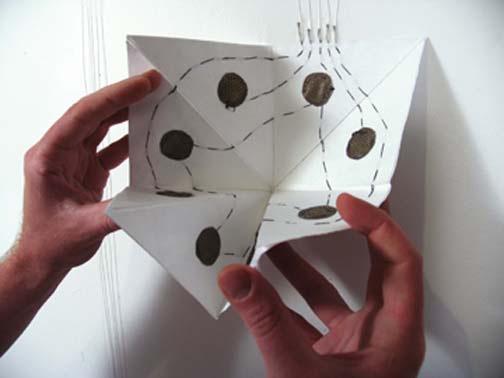
I had many favorites. The two pieces I choose to focus on were not figurative at all but instead were once again patterns and shapes.
It might seem strange to see the work of a traditional veteran sculpture like Erwin Hauer in the technology exhibit at Siggraph. Hauer created works of modernism that began in 1950 and can be found, not only in museums and collections but also in architecture. The patterns in Hauer’s work held the same intrigue that Shlians paper cutting held for me in The Studio section of Siggraph. Each modular constructivism sculpture of looping forms change as the viewer interacts with the piece, light bouncing off form, shadows moving and blending, creating an entirely different piece of artwork from every angle.
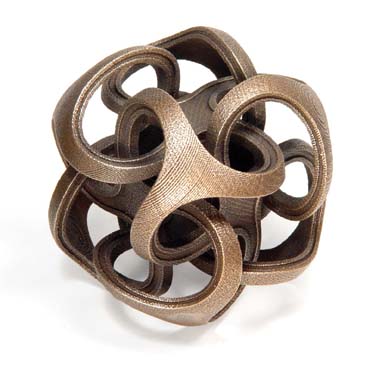
A book of Hauer’s work titled CONTINUA was published in 2004, but it is said that by that time of publishing many of the existing screens had disappeared or were in disrepair, and the laborious task of making molds and casting these screens had not taken place in nearly 40 years. In 2003 computer technologist Enrique Rosado began working with Hauer creating digital files of Hauer’s original work, CONTINUA. Utilizing the new technology of digital files and Computer Numerically Controlled (CNC) milling machines, the team is working to recreate the works of this master.
The journey of translating the designs into the new technology was not easy for Rosado. He found what I have found in my research; often you must push the technology to do what you need it to do, and then wait until it can catch up and become affordable. In a wonderful magazine article about Hauer’s work in Metropolimag.com it states, “These subtleties of balance and proportion were difficult to translate into the software. ‘The computer wants to do what it wants to do,’ Rosado says. ‘And if you’re fastidious, you really have to beat it into submission.”’
My other choice in Design and Computation was actually a student of Hauer. Bathsheba Grossman says that she was an undergraduate at Yale studying math when she first saw Hauer’s work. It was life changing; this is what she wanted to do. After graduating with a degree in math she went on to study sculpture at University of Pennsyvania. Bathsheba transfers math and science into wonderful sculptures utilizes 3D printing in metal and 3D laser etching as the output. She reports that her “traditional” studio has been reduced drastically, as she creates most of her work in the computer. It is because the complexity of her work cannot really be done any other way. She creates in a space that is inaccessible to traditional forms. Immersed in technology, for years she has watched as some traditional artists like jewelers begin to gravitate to working on screen instead of through tiny loops. It is not without its sacrifice, as she admits there is a tactile experience that is the reward of creating manually.
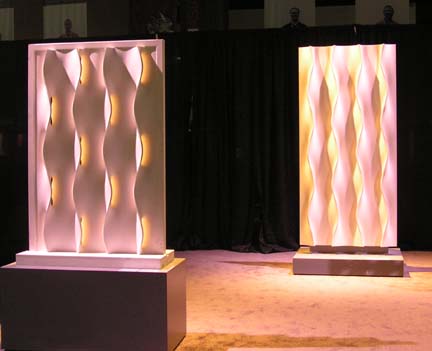
She waits patiently for technology to catch up to her needs as an artist. I learned that the “rough” texture created in the very intriguing process of digital printing in metal is a result of the technology and not part of her design. She is waiting for technology to improve. For those artists pursuing technology in the studio, it may sometimes feel like it progresses at the pace of RealSnailMail.
There were many more discoveries that I have found at Siggraph, which I hope to share in this column in the coming months, along with some wonderful tutorials on the advances in digital technologies as it pertains to the traditional artist. I myself have decided to embrace the technology and share it with as many creative people as I know. Maybe this will increase the snail’s pace and create the demand for the advances in technology that will assist us in our future creations. Though technology is improving and it will help us; in closing I would like to leave you with a quote from Hauer,
“It is an important token reminder for the younger generation and their tutors, that above and beyond the abundance of electronic marvels, the human vision and imagination remains the most important element and that its nurture should not be replaced by excessive reliance on devices.”
Pulling My Hair Out

One to one are classes that Apple offers. They are great just $90.00 a year and you can go in and meet with a mac person about anything one to one for an hour. I have learned a lot in the last year, as shown by the former post. Just thought I would give you a photo montage of my session. Notice the sign over my head in the las photograph says, “No pain, all gain.”
